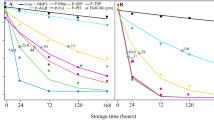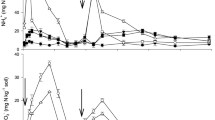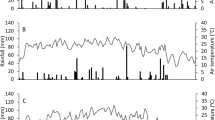Abstract
Purpose
Urease inhibitors provide a simple solution to mitigate ammonia loss from fertilized soil. Consumption of bulk blend fertilizers and compound fertilizers were increased in recent year and its enhanced efficiency and stabilized techniques were urgently required. However, it is essentially unknown if and how the efficacy of urease inhibitors is influenced by the inclusion of phosphorus (P) and potassium (K) fertilizers with urea.
Materials and methods
A laboratory study was therefore conducted to assess the impact of P and K (bulk blend scenario: combing urea with di-ammonium phosphate (DAP); compound fertilizer scenario: nitrogen (N)-P-K proportion as 16-16-16 (CN16) or 32-0-6 (CN32)) and additionally the impact of fertilizer storage duration and temperature on the efficacy of two different urease inhibitors NBPT and Limus® in reducing ammonia volatilization following application to soil.
Results and discussion
Both urease inhibitors significantly reduced ammonia loss from urea regardless of storage temperature and time. However, mixed storage of urea and DAP with urease inhibitors significantly decreased the efficacy of NBPT and Limus® in reducing ammonia loss. Ammonia loss increased exponentially with DAP addition rate and with storage time of the mixture. Storage at a higher temperature (30 °C compared with 20 °C) also reduced the efficacy of the inhibitors. Adding magnesium sulfate (MgSO4) to urea plus Limus® significantly mitigated the negative effect of DAP mixed storage on the efficacy of Limus® regardless of storage temperature and time. The urease inhibitors did not significantly reduce ammonia loss from CN16, but were effective for reducing ammonia loss from CN32.
Conclusions
The efficacy of urease inhibitors was compromised by P fertilizer. Urease inhibitor inclusion in the production of CN32, urea, and its blends (DAP + MgSO4) are recommended as an effective means of reducing the environmental cost causing by intensive agricultural production.







Similar content being viewed by others
References
Abalos D, Jeffery S, Sanz-Cobena A, Guardia G, Vallejo A (2014) Meta-analysis of the effect of urease and nitrification inhibitors on crop productivity and nitrogen use efficiency. Agric Ecosyst Environ 189:136–144
Amtul Z, Atta-ur-Rahman BSP, Siddiqui R, Choudhary M (2002) Chemistry and mechanism of urease inhibition. Curr Med Chem 9:1323–1348
Bergstrom A-K, Jansson M (2006) Atmospheric nitrogen deposition has caused nitrogen enrichment and eutrophication of lakes in the northern hemisphere. Glob Chang Biol 12:635–643
Beusen AHW, Bouwman AF, Heuberger PSC, Van Drecht G, Van Der Hoek KW (2008) Bottom-up uncertainty estimates of global ammonia emissions from global agricultural production systems. Atmos Environ 42:6067–6077
Carmona G, Christianson CB, Byrnes BH (1990) Temperature and low concentration effects of the urease inhibitor N-(n-butyl) thiophosphoric triamide (nBTPT) on ammonia volatilization from urea. Soil Biol Biochem 22:933–937
Chen D, Suter H, Islam A, Edis R, Freney JR, Walker CN (2008) Prospects of improving efficiency of fertiliser nitrogen in Australian agriculture: a review of enhanced efficiency fertilisers. Soil Res 46:289–301
Clark CM, Tilman D (2008) Loss of plant species after chronic low-level nitrogen deposition to prairie grasslands. Nature 451:712–715
de Meij A, Thunis P, Bessagnet B, Cuvelier C (2009) The sensitivity of the CHIMERE model to emissions reduction scenarios on air quality in northern Italy. Atmos Environ 43:1897–1907
Douglass EA, Hendrickson LL (1991) HPLC method for the analysis of the urease inhibitor N-(n-butyl) thiophosphoric triamide and its metabolites. J Agric Food Chem 39:2318–2321
Elaine M (1994) Nitrogenous fertilizers: global distribution of consumption and associated emissions of nitrous oxide and ammonia. Global Biogeochem Cycle 8:411–439
Engel RE, Williams E, Wallander R, Hilmer J (2013) Apparent persistence of -(-butyl) thiophosphoric triamide is greater in alkaline. Soil Sci Soc Am J 77:1424
Engel RE, Towey BD, Gravens E (2015) Degradation of the urease inhibitor NBPT as affected by soil pH. Soil Sci Soc Am J 79:1674
Erisman JW, Sutton MA, Galloway J, Klimont Z, Winiwarter W (2008) How a century of ammonia synthesis changed the world. Nat Geosci 1:636–639
Fan MX, Mackenzie AF (1993) Urea and phosphate interactions in fertilizer microsites: ammonia volatilization and pH changes. Soil Sci Soc Am J 57:839–845
Farmaha BS, Sims AL (2013) Yield and protein response of wheat cultivars to polymer-coated urea and urea. Agron J 105:229–236
Fowler D et al (2015) Effects of global change during the 21st century on the nitrogen cycle. Atmos Chem Phys 15:13849–13893
Garrett RH, Grisham CM (2005) Biochemistry, Third ed. Thomson Learning, Inc. Belemont, CA.
Griffith SM, Huang XHH, Louie PKK, Yu JZ (2015) Characterizing the thermodynamic and chemical composition factors controlling PM2.5 nitrate: insights gained from two years of online measurements in Hong Kong. Atmos Environ 122:864–875
Hasler K, Bröring S, Omta SWF, Olfs HW (2015) Life cycle assessment (LCA) of different fertilizer product types. Eur J Agron 69:41–51
Hendrickson LL, Douglass EA (1993) Metabolism of the urease inhibitor N-(n-butyl) thiophosphoric triamide (NBPT) in soils. Soil Biol Biochem 25:1613–1618
Huang J et al (2017) Nitrogen mobility, ammonia volatilization, and estimated leaching loss from long-term manure incorporation in red soil. J Integr Agric 16:2082–2092
Jiang Y, Deng A, Bloszies S, Huang S, Zhang W (2017) Nonlinear response of soil ammonia emissions to fertilizer nitrogen. Biol Fertil Soils 53:269–274
Kampa M, Castanas E (2008) Human health effects of air pollution. Environ Pollut 151:362–367
Kumar S, Bauddh K, Barman SC, Singh RP (2014) Amendments of microbial biofertilizers and organic substances reduces requirement of urea and DAP with enhanced nutrient availability and productivity of wheat (Triticum aestivum L.). Ecol Eng 71:432–437
Li QQ (2014) Effect of urease inhibitor LIMUS on ammonia mitigaton and crop yield and nitrogen use efficiency in different croplands of China. China Agricultural University
Li Q et al (2015) Effect of a new urease inhibitor on ammonia volatilization and nitrogen utilization in wheat in north and northwest China. Field Crop Res 175:96–105
Li Q, Cui X, Liu X, Roelcke M, Pasda G, Zerulla W, Wissemeier AH, Chen X, Goulding K, Zhang F (2017) A new urease-inhibiting formulation decreases ammonia volatilization and improves maize nitrogen utilization in North China Plain. Sci Rep 7:43853. https://doi.org/10.1038/srep43853
Liu X, Zhang Y, Han W, Tang A, Shen J, Cui Z, Vitousek P, Erisman JW, Goulding K, Christie P, Fangmeier A, Zhang F (2013) Enhanced nitrogen deposition over China. Nature 494:459–462
Miserque O, Pirard E (2004) Segregation of the bulk blend fertilizers. Chemometr Intell Lab 74:215–224
Misselbrook TH, Sutton MA, Scholefield D (2006) A simple process-based model for estimating ammonia emissions from agricultural land after fertilizer applications. Soil Use Manag 20:365–372
Pan B, Lam SK, Mosier A, Luo Y, Chen D (2016) Ammonia volatilization from synthetic fertilizers and its mitigation strategies: a global synthesis. Agric Ecosyst Environ 232:283–289
Gregor Pasda, Alexander Wissemeier, Laura Vance, Marcela Muller, Alexander Ungru, Matthias Lex, Karl-Heinrich Schneider, Maarten Staal, Wolfram Zerulla, Markus Schmid (2016) A novel combination of urease inhibitors and its formulation with better performance concerning biology, handling, transport and storage compared to existing products, 19th nitrogen workshop, June 27-29, Skara, Sweden
Pozzer A, Tsimpidi AP, Karydis VA, de Meij A, Lelieveld J (2017) Impact of agricultural emission reductions on fine-particulate matter and public health. Atmos Chem Phys 17:12813–12826
San Francisco S, Urrutia O, Martin V, Peristeropoulos A, Garcia-Mina JM (2011) Efficiency of urease and nitrification inhibitors in reducing ammonia volatilization from diverse nitrogen fertilizers applied to different soil types and wheat straw mulching. J Sci Food Agric 91:1569–1575
Schraml M, Gutser R, Maier H, Schmidhalter U (2016) Ammonia loss from urea in grassland and its mitigation by the new urease inhibitor 2-NPT. J Agric Sci 154:1453–1462
Silva AGB, Sequeira CH, Sermarini RA, Otto R (2017) Urease inhibitor NBPT on ammonia volatilization and crop productivity: a meta-analysis. Agron J 109:1–13
Soares JR, Cantarella H (2012) Ammonia volatilization losses from urea treated with N-(n-butyl) thiophosphoric triamide (NBPT) stored at different temperatures, the International 17th Nitrogen Workshop
Suter HC, Pengthamkeerati P, Walker C, Chen D (2011) Influence of temperature and soil type on inhibition of urea hydrolysis by N-(n-butyl) thiophosphoric triamide in wheat and pasture soils in south-eastern Australia. Soil Res 49:315–319
Sutton MA et al (2013) Towards a climate-dependent paradigm of ammonia emission and deposition. Philos Trans R Soc Lond Ser B Biol Sci 368:20130166
Tingyu L et al (2018) Enhanced-efficiency fertilizers are not a panacea for resolving the nitrogen problem. Glob Chang Biol 24:e511–e521
Tsimpidi AP, Karydis VA, Pandis SN (2007) Response of inorganic fine particulate matter to emission changes of sulfur dioxide and ammonia: the eastern United States as a case study. J Air Waste Manage Assoc 57:1489–1498
Wang S, Xing J, Jang C, Zhu Y, Fu JS, Hao J (2011) Impact assessment of ammonia emissions on inorganic aerosols in East China using response surface modeling technique. Environ Sci Technol 45:9293–9300
Wang G et al (2016) Persistent sulfate formation from London fog to Chinese haze. Proc Natl Acad Sci U S A 113:13630–13635
Watson CJ, Miller H, Poland P, Kilpatrick DJ, Allen MDB, Garrett MK, Christianson CB (1994) Soil properties and the ability of the urease inhibitor N-(n-BUTYL) thiophosphoric triamide (nBTPT) to reduce ammonia volatilization from surface-applied urea. Soil Biol Biochem 26:1165–1171
Watson CJ, Akhonzada NA, Hamilton JTG, Matthews DI (2008) Rate and mode of application of the urease inhibitor N-(n-butyl) thiophosphoric triamide on ammonia volatilization from surface-applied urea. Soil Use Manag 24:246–253
Ye Y, Liang X, Chen Y, Liu J, Gu J, Guo R, Li L (2013) Alternate wetting and drying irrigation and controlled-release nitrogen fertilizer in late-season rice. Effects on dry matter accumulation, yield, water and nitrogen use. Field Crop Res 144:212–224
Zhang Y, Luan S, Chen L, Shao M (2011) Estimating the volatilization of ammonia from synthetic nitrogenous fertilizers used in China. J Environ Manag 92:480–493
Zheng J, Kilasara MM, Mmari WN, Funakawa S (2018) Ammonia volatilization following urea application at maize fields in the East African highlands with different soil properties. Biol Fertil Soils 54:411–422
Zhou Z, Shen Y, Du C, Zhou J, Qin Y, Wu Y (2017) Economic and soil environmental benefits of using controlled-release bulk blending urea in the North China Plain. Land Degrad Dev 28:2370–2379
Zhu Q et al (2016) The contribution of atmospheric deposition and forest harvesting to forest soil acidification in China since 1980. Atmos Environ 146:215–222
Funding
This study was supported by the State Key R&D Program (2017YFD0200101), the National Natural Science Foundation of China (41425007), and the UK BBSRC/NERC Newton-funded project UK-China Virtual Joint Centre for Improved Nitrogen Agronomy (CINAg) (BB/N013468/1). The authors appreciate the support from the BASF SE for funding and the Limus® products.
Author information
Authors and Affiliations
Corresponding author
Additional information
Responsible editor: Qiaoyun Huang
Publisher’s note
Springer Nature remains neutral with regard to jurisdictional claims in published maps and institutional affiliations.
Electronic supplementary material
ESM 1
(DOCX 1296 kb)
Rights and permissions
About this article
Cite this article
Sha, Z., Lv, T., Staal, M. et al. Effect of combining urea fertilizer with P and K fertilizers on the efficacy of urease inhibitors under different storage conditions. J Soils Sediments 20, 2130–2140 (2020). https://doi.org/10.1007/s11368-019-02534-w
Received:
Accepted:
Published:
Issue Date:
DOI: https://doi.org/10.1007/s11368-019-02534-w




